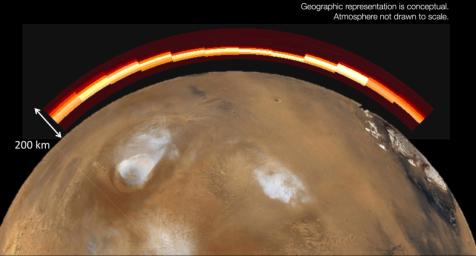This graphic depicts what the Martian atmosphere would have looked like to a viewer with ultraviolet-seeing eyes during and shortly after a meteor shower on Oct. 19, 2014. It combines an atmosphere image from the Imaging Ultraviolet Spectrograph (IUVS) on NASA's MAVEN spacecraft with a conceptual illustration of how the atmosphere lies over Mars. The IUVS image records bright emission from ionized magnesium added to Mars' atmosphere by a meteor shower of dust from comet C/2013 A1 Siding Spring on that date.
The IUVS image covers a scan of Mars' upper atmosphere about 120 miles (about 200 kilometers) in altitude. The planet illustration is not shown to scale beneath the UVIS image. The nucleus of comet Siding Spring passed within about 87,000 miles (139,500 kilometers) of Mars. Some of the dust released by the nucleus many months earlier reached the Martian atmosphere and vaporized as it entered the atmosphere at high velocity.
MAVEN is NASA's Mars Atmosphere and Volatile Evolution (MAVEN) spacecraft. NASA Goddard Space Flight Center in Greenbelt, Md., manages the MAVEN project for NASA's Science Mission Directorate, Washington, and built some of the science instruments for the mission. MAVEN's principal investigator is based at the University of Colorado's Laboratory for Atmospheric and Space Physics in Boulder. The university provided science instruments and leads science operations, as well as education and public outreach, for the mission. Lockheed Martin Space Systems, Denver, built and operates the spacecraft. The University of California at Berkeley's Space Sciences Laboratory provided instruments for the mission. JPL, a division of the California Institute of Technology in Pasadena, provides navigation support and Deep Space Network support, NASA's Jet Propulsion Laboratory in Pasadena, California, provides navigation and Deep Space Network support, as well as the Electra telecommunications relay hardware and operations.
MAVEN is NASA's Mars Atmosphere and Volatile Evolution (MAVEN) spacecraft. NASA Goddard Space Flight Center in Greenbelt, Md., manages the MAVEN project for NASA's Science Mission Directorate, Washington, and built some of the science instruments for the mission. MAVEN's principal investigator is based at the University of Colorado's Laboratory for Atmospheric and Space Physics in Boulder. The university provided science instruments and leads science operations, as well as education and public outreach, for the mission. Lockheed Martin Space Systems, Denver, built and operates the spacecraft. The University of California at Berkeley's Space Sciences Laboratory provided instruments for the mission. NASA's Jet Propulsion Laboratory, a division of the California Institute of Technology in Pasadena, provides navigation and Deep Space Network support, as well as the Electra telecommunications relay hardware and operations.
For more information about MAVEN, visit http://www.nasa.gov/maven and http://lasp.colorado.edu/home/maven/.
For more information about NASA's Mars Exploration Program, see http://marsprogram.jpl.nasa.gov.

 Planetary Data System
Planetary Data System












